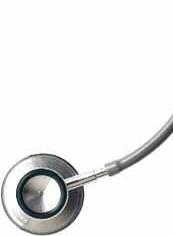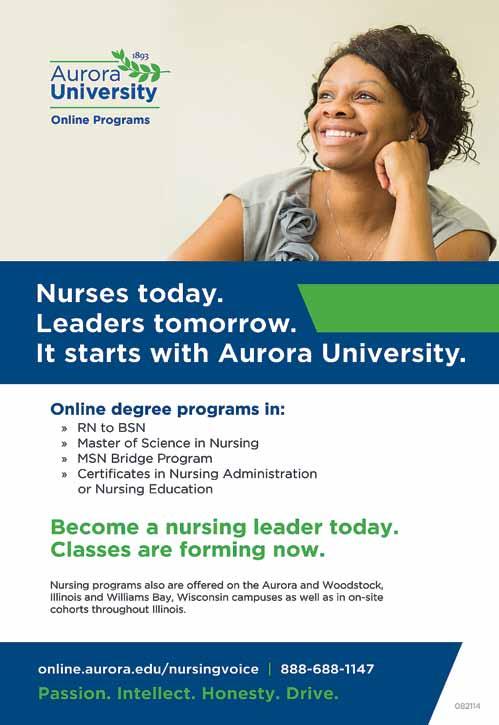Nursing Voice
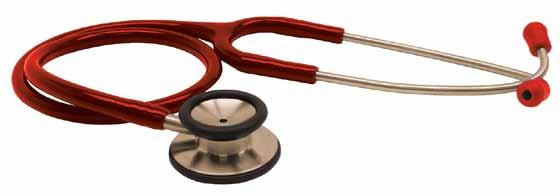


American Nurses Association Illinois welcomes new ANA President Pamela Cipriano, PhD, RN, NEA-BC, FAAN! Cipriano was elected at the ANA Membership Assembly on June 14 to a two-year term. Here is a little more about President Cipriano and her hopes for the future of ANA and the profession.

Getting to Know ANA’s New President
Prior to becoming ANA president, Cipriano served as senior director for health care management consulting at Galloway Advisory by iVantage. She also has held faculty and health system leadership positions at the University of Virginia (UVA) since 2000.
Cipriano is known nationally as a strong advocate for health care quality, and serves on a number of boards and committees for high-profile organizations, including the National Quality Forum and the Joint Commission. She

was the 2010-11 Distinguished Nurse Scholar-in-Residence at the Institute of Medicine.
A longtime ANA member, Cipriano has served two terms on the ANA Board of Directors and was the recipient of the association’s 2008 Distinguished Membership Award. She acted as the inaugural editor-inchief of American Nurse Today, ANA’s official journal, from 2006-14, and is currently a member of the Virginia Nurses Association.
Vision for the Future of ANA
In a recent conversation with The American Nurse, Cipriano shared her vision for ANA by outlining three priorities for her presidency.
First, she will focus on ANA’s “core strengths,” which include: political advocacy, efforts around safe staffing and healthy work environments, and fighting for nurses’ rights to control their profession and practice to the full extent of their education and licensure.
Second, Dr. Cipriano will lead membership growth and retention. “I strongly believe in the old saying, ‘There’s strength in numbers,’” she said.
The third priority for her first term includes positioning nurses to exert greater influence in the transformation of health care. “It’s very important for ANA to make sure nurses are in prime positions and key decision-making groups so our voice is there at every turn,” she said.
Finally, what does President Cipriano want members around the country to keep in mind? Optimism. “We are making a number of strides,” she said. “We’re going to need all of our members...if we want to truly achieve a new direction in health care.”
To read more about President Cipriano, please visit: www.theamericannurse.org/index.php/2014/06/30/meetanas-new-president/
ANA-Illinois’ Nurses PAC and ISAPN PAC proudly endorse Martha Shugart for the Illinois House of Representatives, District 75!
Martha Shugart, RN, is a name to remember! A long-time member of the Morris community, Shugart is a candidate for State Representative in the 75th District. If elected, she would be the first nurse to ever serve in the General Assembly
Shugart provides hands-on nursing care at Morris Hospital and has more than 25 years of experience in various nursing specialties. She is dedicated to her community, volunteering her time with a number of community boards and organizations.


Capitalizing on the theme of “Nurses Leading the Way,” ANA-Illinois President, Pam Brown PhD, RN, ANEF and Vice President, Ann O’Sullivan MSN, RN, CNE, NE-BC, ANEF and some 350 representatives and observers to the American Nurses Association’s (ANA) Membership Assembly displayed their leadership skills by participating in dialogue forums to offer strategies on three key topics: nurses’ full practice authority, access to palliative care and high-performing interprofessional teams. Assembly representatives subsequently voted on specific recommendations for the ANA Board of Directors to consider.

Now is the time to flex nursing’s political muscle and elect Martha Shugart, a candidate who knows the needs of Illinois nurses first-hand!
“I’m a nurse, a mother and a volunteer – I never expected I’d be running for state representative,” Shugart said. “But as Springfield weighs major decisions about the nursing community and the direction of our state, I feel that now, more than ever, our voices and our values need to be heard. For too long, I’ve watched politicians put their own interests ahead of middleclass families.
Dear Illinois Nurse Colleagues,
“A bird doesn’t sing because it has an answer, it sings because it has a song.”
“I’ve learned that you shouldn’t go through life with a catcher’s mitt on both hands; you need to be able to throw something back.”
“If you find it in your heart to care for somebody else, you will have succeeded.”
Maya Angelou
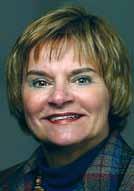
With the recent passing of author and poet, Maya Angelou, I find myself hearing and reflecting on her wise and often witty words. I am sharing some of her quotes with you as I find that many of her messages resonate with nursing and what we are about with the work of the Illinois Nurses Foundation. Some recurring themes in her messages are about doing what you love, caring for others, receiving graciously, and giving back. We are nurses because we have a gift for it and because we care. We care not only for our patients but for our profession. Because of this we are committed to honoring our past and ensuring a future of continued practice excellence within our profession. How and why we fulfill this commitment is again reflected in Maya Angelou’s words?
“What humility does for one is it reminds us that there are people before me. I have already been paid for. And what I need to do is prepare


ATTORNEYS FOR ILLINOIS NURSES
James B. Goldberg
40 Years of Healthcare Experience
Areas: Licensing, Disciplinary Proceedings, Hospital Termination, Nursing Home Proceedings and All Nursing Rights Issues.
We care about nurses and travel throughout Illinois
• Free Consultation
• All Communications Privileged
• All Calls or Emails returned immediately
Contact James B. Goldberg, 312-735-1185
120 S. Riverside Plaza Suite 1675, Chicago, Illinois 60606
Email: jgoldberg@goldberglawoffice.com Goldberglicensing.com
myself so that I can pay for someone else who has yet to come but who may be here and needs me.”
“It is a no-fail, incontrovertible reality: If you get, give. If you learn, teach. You can’t do anything with that except do it.”
“I have found that among its other benefits, giving liberates the soul of the giver.”
We give by sharing time, treasure and talent to participate in the work of the profession. Participating in the profession’s work means going beyond basic job requirements to share nursing knowledge with others through education and research activities to develop best practices, to give time to do the work of the profession by volunteering for professional association work to develop standards of practice, ethical guidelines and advocate for nursing and healthcare issues, and to give back to the profession through philanthropic investment.
I hope that you find Maya Angelou’s words inspiring and that you will reflect upon how these words apply to your nursing career. Today’s world creates a lot of competing demands for our time and money and it can be hard to find the resources to contribute time, talent and treasure to one more thing. I encourage you to look at how sharing your resources with nursing might benefit the profession as well as you as a person and a nurse. As you consider what you want for nursing and for your nurse self, I leave you with some final thoughts by Maya Angelou;
“Whatever you want to do, if you want to be great at it, you have to love it and be able to make sacrifices for it.”
“If one is lucky, a solitary fantasy can totally transform one million realities.”
Read more Maya Angelou quotes at http://www. brainyquote.com/quotes/authors/m/maya_angelou_2. html#3jkY0jLTx2uujtwi.99
RN to BSN program
Contact us at 217-581-7049
Email nursing@eiu.edu
• Classes offered totally online each semester
• Capstone course offered in the Spring
and Fall Semesters
• Accessible! Affordable! Achievable!
• Laptops and iPods loaned to students
• High Success Rates for Program Completion!
• Textbook Rental fees & Technology fees included in tuition

www.eiu.edu/nursing
Officers
Maureen Shekleton, PhD, RN, FAAN President
Alma Labunski, PhD, MS, RN Vice President
Cathy Neuman, MSN, RN, CNAA Secretary/Treasurer
Directors
Cheryl Anema, PhD, RN
Maria Connolly, PhD, CNE, ANEF, FCCM
P. Joan Larsen, RN
Sarah Gabua, DNP(c), RN
Karen Egenes, EdD, MSN, MA, RN
Linda Olson, PhD, RN, NEA-BC
Lauren Mardirosian, BSN, RN
Diana Cafi, MSN, MHA, RN, CLNC
Officers
2013-2015 ANA-Illinois Board of Directors
Pamela Brown, PhD, RN President
Ann O’Sullivan, MSN, RN, CNE, NE-BC, ANEF Vice President
Dan Fraczkowski, MSN, RN Treasurer
Sarah Gabua, DNP(c), RN Secretary
Directors
Diana Cafi, MSN, MHA, RN, CLNC
Deb Eagan, BSN, RN
Karen Egenes, EdD, MSN, MA, RN
Karla Luxner, BSN, RN, DNP, CNS, RN-C
Bonnie Salvetti, BSN, RN
Editorial Committee
Editor Emeritus
Alma Labunski, PhD, MS, RN
Chief Editors
Lisa Anderson-Shaw, DrPH, MA, MSN
Karen Mayville, MSN, PhD, RN
Members
Cheryl Anema, PhD, RN
Margaret Kraft, PhD, RN
Linda Olson, PhD, RN, NEA-BC
Executive Director
Susan Y. Swart, MS, RN, CAE
ANA-Illinois/Illinois Nurses Foundation
Article Submission
• Subject to editing by the INF Executive Director & Editorial Committee
• Electronic submissions ONLY as an attachment (word document preferred)
• Email: info@ana-illinois.org
• Subject Line: Nursing Voice Submission: Name of the article
• Must include the name of the author and a title.
• INF reserves the right to pull or edit any article / news submission for space and availability and/or deadlines
• If requested, notification will be given to authors once the final draft of the Nursing Voice has been submitted.
• INF does not accept monetary payment for articles.
Article submissions, deadline information and all other inquiries regarding the Nursing Voice please email: info@ana-illinois.org
Article Submission Dates
(submissions by end of the business day)
January 15th
April 15th
July 15th
October 15th
Advertising: for advertising rates and information please contact Arthur L. Davis Publishing Agency, Inc., 517 Washington Street, P.O. Box 216, Cedar Falls, Iowa 50613 (800-626-4081), sales@ aldpub.com. ANA-Illinois and the Arthur L. Davis Publishing Agency, Inc. reserve the right to reject any advertisement. Responsibility for errors in advertising is limited to corrections in the next issue or refund of price of advertisement.


Acceptance of advertising does not imply endorsement or approval by the ANA-Illinois and Illinois Nurses Foundation of products advertised, the advertisers, or the claims made. Rejection of an advertisement does not imply a product offered for advertising is without merit, or that the manufacturer lacks integrity, or that this association disapproves of the product or its use. ANA-Illinois and the Arthur L. Davis Publishing Agency, Inc. shall not be held liable for any consequences resulting from purchase or use of an advertiser’s product. Articles appearing in this publication express the opinions of the authors; they do not necessarily reflect views of the staff, board, or membership of ANA-Illinois or those of the national or local associations.



I don’t know about you, but I love this “echo” of the polar vortex as I’m writing this in mid-July!! I hope all of you are finding time to relax and vacation with friends or family. I want to thank you for taking the time to read the Voice, and for your support of ANAIllinois. I’ve learned that there is some confusion about who and/ or why you receive the Voice in your home. All registered nurses receive the Voice courtesy of ANA-Illinois. As professional nurses, you are able to support the profession of nursing in Illinois by joining ANA-Illinois as a member. Receiving the Voice does not mean you are a member. I encourage all nurses to join their professional organization, so please, if you are not a member, visit the ANA-Illinois web site and join today!! It has been my experience (over 30 years) that I receive much more than I’ve ever given to the professional organization. I also want to sincerely thank all of you who are members of ANA-Illinois. Thanks to you, our membership is growing!!
It is my honor to share with you that Pam Cipriano, Ph.D., RN, NEA-BC, FAAN of Charlottesville, VA was elected as President of the American Nurses Association (ANA) representing 3.1 million registered nurses. Ms. Cipriano served as the first editor-in-chief of ANA’s official journal, American Nurse Today. Ms. Cipriano’s background includes being the senior director at Galloway Consulting and holding the position of Chief Clinical Officer at the University of Virginia Health System, as well as that of research associate professor at University of Virginia School of Nursing.




In the previous publication, I asked for feedback on certification for RNs. I want to briefly share the results of the survey. One hundred and sixty nine (169) responded by completing the online survey. THANK YOU. Most of the respondents are currently certified (85%) in a nursing specialty, most are BSN or MSN (87%) prepared, and most (78%) are 50 years of age or older. Over 65% of respondents plan to retire in the next 10 years with the largest clusters retiring in 2016-17 (33%), and 2019-20 (24%). Over 75% believe certification is very important, about 20% somewhat important, and less than 10% indicated certification was not important. About 20% of respondents plan to become certified, with 85% already certified; only 5% are not interested in certification. The survey provided a great deal of narrative feedback, which I cannot share in this publication but we plan to post a summary on the ANA-Illinois website.
The ANA-Illinois expert panel is investigating the evolving scope of practice for the registered nurse. As you read the article related to this, I want to personally encourage you to share your expertise by completing that survey. Your input and willingness to serve as a focus group member will drive changes in the Illinois Nursing Act of 2017. Thank You for your commitment to Nursing!!
News out of New York is worthy of your attention, ANA-New York has shared that the legislation on the Advancement of Nursing Education (BS in Ten) passed through the NY Assembly by a vote of 126 to 8. The Senate has yet to act on this legislation. We will keep you posted.
I am very excited to ask the professional nurses of Illinois to support an IL license Plate honoring nurses. The proceeds from this plate will go to the Illinois Nurses Foundation to support scholarships for nurses, a very big win for nursing!!






Nurse Candidate continued from page 1
We need leaders in Illinois who will put others first. I’m asking for your help in sending a nurse to treat what’s wrong in Springfield.”
Martha Shugart will be a strong voice for her community and nurses statewide, but she needs our help. Having a nurse colleague in Springfield will benefit the entire profession. No matter where you live in Illinois, please consider helping Martha with a personal contribution, or offer to spend a few hours in Morris, Minooka, and surrounding areas as a campaign volunteer. The campaign office address:
Friends of Martha Shugart PO Box 959
Morris, IL 60450
Telephone: 815-942-1088
FAX: [815-741-9026]
E-mail: Martha@martha2014.com
City Colleges of Chicago is now hiring for the following positions:
Full-Time & Part-Time
Nursing Faculty
Qualifications: Master’s degree in Nursing, preferably nursing education supplemented by a minimum of 2 years full-time teaching college-level nursing courses. Experience in assessment of student learning outcomes and remediation strategies are required. To apply, please contact Dan Boyd, Talent Acquisition Director dboyd76@ccc.edu
Chicago residency is required for all full-time employees within six (6) months of hire.











The first forum addressed “Scope of Practice – Full Practice Authority for All RNs,” a topic proposed by the South Carolina Nurses Association. Participants engaged in table discussions around legislation mandating physician supervision of APRNs over a certain period of time before APRNs could gain full practice authority; major practice barriers for RNs; and potential strategies to move past “turf” battles as new roles and categories of health care workers evolve.
In discussing practice barriers for RNs, participants commented on a lack of role clarity and no separate, visible reimbursement for RN services. They also noted that promoting interprofessional, team-based care, valuing


Advantage Nursing Services is seeking LPNs & RNs for our Pediatric Private Duty cases
*Nurses applying to work in Illinois must have one year practicing experience as a LPN or RN
Contact our 24 hour Recruitment Line at 1-800-830-2737 for openings or apply at: www.ansjobs.com
For Assessments and services contact our 24 hour centralized intake line: 1-866-383-3535 www.advantage-nursing.com
all members of the health care team and clarifying nurses’ roles could help diminish turf battles.
Representatives then voted to recommended that ANA support interprofessional education, practice and research to promote the full scope of RN practice; encourage nursing research to compare full practice authority states, transition to APRN practice states, and restricted APRN states; educate the public, policy makers and other health professionals about emerging roles and overlapping responsibilities; and support eliminating practice agreements between APRNs and physicians.
In the second forum, guest speakers addressed the “Integration of Palliative Care into Health Care Delivery Systems: Removing Barriers, Improving Access.” This topic was proposed by the Ohio Nurses Association (ONA), which voiced ONA members’ concerns about a lack of access to and payment for palliative and hospice care.
Kathryn M. Lanz, DNP, ANP, GNP, ACHPN, director of geriatric services for the University of Pittsburgh Medical Center’s Palliative and Supportive Institute, started her presentation with some troubling statistics based on a national survey of Americans. Sixty-five percent of responders reported having loved ones who died in pain, half of older Americans visited an ED in the last month of life, and 70 percent of the public worries about end-of-life issues.
That said, she noted that there are good palliative care models, which take a person-directed approach to care and are value-based. She further reported that implementing those models improves patients’ symptoms, quality and length of life, as well as family satisfaction and bereavement outcomes.
Key characteristics of effective models include family and social support, goal setting in which patients’ desires match their treatment, and a flexible approach to “dosing” – that is, the appropriate type of care is given at the right time as patients’ symptoms wax and wane, according to Lanz.
Marijo Letizia, PhD, RN, APN/ANP-BC, FAANP, professor and associate dean of masters and DNP programs at Loyola University, Chicago, addressed the importance of improving the knowledge and skills of basic and advanced care nurses in the area of palliative care. She noted that both formal preparation and continuing education coursework should be implemented -- for every nurse and specialty.
“We don’t have to reinvent the wheel,” said Letizia about creating palliative care content. She mentioned helpful educational resources created by the Hospice and Palliative Nurses Association (HPNA), an organizational affiliate of ANA.
For example, HPNA and ANA have worked collaboratively on many initiatives, including developing Palliative Nursing: Scope and Standards of Practice.
After sharing information, Assembly representatives formally voted on recommendations asking ANA to promote and support payment models to improve access to palliative and hospice care, including nursing care provided by both RNs and APRNs; advocate for comprehensive integration of palliative and hospice care education at all levels of nursing educational programs and professional development programs; and support developing and expanding models of nursing care that include advanced care planning for early identification and support of patients’ preferences for palliative and hospice services.
Looking at high-performing, interprofessional teams
The final forum explored high-performing, interprofessional teams, and featured presentations by Kathryn Rugen, PhD, FNP-BC, from the VA Centers of Excellence in Primary Care Education, and Tara Cortes, PhD, RN, FAAN, executive director of the Hartford Institute for Geriatric Nursing.
Cortes first addressed the history of team-based care, noting that the Institute of Medicine has been talking about interprofessional education and practice since 1970. She then suggested several strategies to advance high-performing, interprofessional practice, including writing it into organizational policies and procedures and performance indicators; breaking down the silos that exist between academia and practice; and developing and implementing new integrated models of care.
Rugen spoke specifically about the ongoing efforts at the Department of Veterans Affairs Centers of Excellence in Primary Care Education.
She noted that physician residents and NP trainees, along with core clinic members, “learn to work in – and lead – team-based, patient-centered care that they can use in their future practice.”
The centers also focus on developing and testing innovative curriculum models, and curricula and learning activities are geared to promote shared decision-making, sustained relationships, interprofessional collaboration and performance improvement, according to Rugen.
Forum participants then weighed in with their comments. Representatives offered ways ANA can support nurses to further engage and assume roles to advance highperforming interprofessional teams across care settings. For example, participants suggested engaging hospice and mental health professionals, because they have been using this model for 20- 30 years. They also suggested supporting multi-day training for faculty and developing innovative resources that incorporate interprofessional simulation and social interaction opportunities for acculturation, among others.
Assembly representatives ultimately recommended asking ANA to consider educating nurses about the application and impact of evolving patient-centered, teambased care models on patient outcomes, and identify metrics that evaluate the impact of high-performing, interdisciplinary health care teams on patient outcomes.





Lead a new team of nurses through their education – by educating others to become a nurse with the MSN – Nurse Educator program at Methodist College
Combine your clinical skills and learning strategies to expand your career in education
• Gain the knowledge to teach the next generation of nurses
• Develop new skills while positively enhancing your career path
• Influence the future quality of patient care
The General Election of 2014 in Illinois is an exciting one! We have one of the most closely watched gubernatorial elections in the country.
ANA-Illinois and ISAPN members are often asked, “Which candidate for Governor better supports nursing’s goals?” “Where do they stand on healthcare issues affecting Illinois?” And, “what is their view on APN full practice authority (nursing’s key priority in 2015)?
Neither organization is making an endorsement in the Governor’s race. In an effort to assist you…the Illinois nurse-voters…in making an informed decision when you go to the polls for the November 4th election, we are providing a side-by-side document
What is your position on the full utilization of APNs in Illinois?
“APNs need to be given more ability by law, if a physician is not available and access to APN care is needed. I want to help pass full practice authority for APNs as Illinois is growing and needs access to care. I have read the bill and I know ISMS opposes it but you can do a lot in the veto session.”
What role do you see the Governor’s staff and other governmental agencies playing in eliminating barriers to APN practice?
“My team worked with the Speaker and Senate President on a bill this past session. I will use every tool at my disposal; my position, staff as well as building a media campaign around this issue. I am inspired and we should have done a better job supporting full authority two years ago. Nursing promotes wellness and trust with the healthcare community. In January, I created the new Governor’s Office of Health Innovation and Transformation. We are actively engaging hundreds of stakeholders, including the RN and APN associations, to improve health. One workgroup led by DPH director, Dr. Hasbrouck, is addressing workforce issues, including scope of practice laws that limit professionals from working at the top of their training and education, with full practice opportunities for APN’s high on their list.”
Some insurers will not pay for care delivered by APNs. What will you do to ensure people have access to care provided by an APN with full insurance payment.
“I think we have to look into this to identify ways to overcome this barrier and determine if legislation is necessary.”
Illinois is moving forward with many changes to healthcare delivery due to the ACA, including care coordination, continuity of care, a focus on prevention within the community. What do you see the rol of the registered nurse in providing these services?
“I do not want the role of the nurse to be taken for granted. Nurses are essential members of a care team working with doctors and community health workers to ensure the health and well being of their patients. We need to make investments, especially for nursing; it’s a vocation not a career. We need a healthier society, more wellness without sacrificing quality. The Alliance for Health process we initiated now engages 900 stakeholders in 5 work groups and 25 committees all focused on improving health and quality.
With the expansion of Medicaid eligibility and care coordination, it means closer scrutiny regarding who is eligible and who is not. What is your plan to provide availability of healthcare services as people ‘churn’ into and out of Medicaid related to insurance costs?
“The Medicaid waiver has been filed, I went to Washington DC and talked with CMS to tell them all that had been done. It is a challenge to see the churn in and out of the system, but also an opportunity with enrolling 613,000 people and may get as high as 750,000. We are liberal in who qualifies for Medicaid; I want people to access coverage. We need a universal system where people don’t ‘fall off’. Until we have a universal system we are working through the Alliance for Health for commercial health plans, like Blue Cross, and providers, like Presence, to develop integrated delivery systems so that people get the same high quality care regardless of whether they›re covered by Medicaid or a private health plan.
What steps will you take to lower healthcare costs while maintaining or improving health outcomes?
“I created a new office, Governor’s Office of Health Innovation and Transformation to achieve better health with lower costs throughout the state. For Medicaid and commercial insurance. The office convenes hundreds of stakeholder, including nurses, to develop details on how to do this. Preliminary work due in December. Additionally we must ensure we have the revenues to fund the programs, make investments, which will pay dividends in the future. I want to put Illinois on a better path to wellness.”
What measures do you support in collecting valuable demographic data on the current healthcare workforce to assist in planning for an adequate workforce for patient care in Illinois?
“I support innovative ideas on how to gather data with proper funding. We need to use as much information as possible to find out where the people are, what is needed, and where gaps need to be filled.”
(below) of how each answered questions posed to them by ISAPN and ANA-Illinois. Identified members of the two organizations, the Executive Director and lobbyists met in person with both candidates. Questions had been previously developed and asked of each candidate in an unbiased manner.
Each candidate was given general background information prior to being asked the specific questions. Below are the questions asked and answers given by each candidate: current Governor Pat Quinn (D) and challenger Bruce Rauner (R).
Please make voting a priority! Nursing has a formidable voting block, with 179,000 licensed nurses. Make nursing’s voice heard!!
Family members are/were nurses: Mother and aunt.
What is your position on the full utilization of APNs in Illinois?
“I support free choice in health care decisions. Patients must have choices. I am learning about all the issues, but my basic philosophy is to knock down barriers and support competition. I commit to a partnership with you in finding the best way to provide quality care at the lowest possible cost. I don’t understand why the legislature has not passed this already.”
What role do you see the Governor’s staff and other governmental agencies playing in eliminating barriers to APN practice?
“I believe in a collaborative and cooperative relationship with government and business, including healthcare. I will communicate with you and want a great team of people to lead and work in the agencies, those who have a deep level of knowledge and expertise. I commit to come to you, as experts, to seek help identifying those individuals.”
Some insurers will not pay for care delivered by APNs. What will you do to ensure people have access to care provided by an APN with full insurance payment.
“I am surprised insurance companies would be pushing back when care provided by APNs could be at a cost savings to them. We need to make sure that we are increasing access to services that improve health care outcomes and reduce costs. I look forward to working with you to find market-based and commonsense solutions to improve insurance coverage in the state.”
Illinois is moving forward with many changes to healthcare delivery due to the ACA, including care coordination, continuity of care, a focus on prevention within the community. What do you see the role of the registered nurse in providing these services?
“I think nurses play a pivotal role in providing higher quality healthcare in the most efficient way we can.”
With the expansion of Medicaid eligibility and care coordination, it means closer scrutiny regarding who is eligible and who is not. What is your plan to provide availability of healthcare services as people ‘churn’ into and out of Medicaid related to insurance costs?
“Healthcare delivery is a big challenge. I like some parts of the ACA; some I don’t. I do believe we need to have continuity of care, especially for those who need it most.”
What steps will you take to lower healthcare costs while maintaining or improving health outcomes?
“The greatest health care challenge that our state faces has nothing to do with the delivery of health care. It’s our unhealthy budget. For too long we’ve relied on gimmicks and accounting games to balance our budget. We’ve turned a great state into one that job creators are fleeing. As long as the state budget is anemic, we won’t be able to appropriately invest in health care or our social services safety net. I’ve laid out reforms that will put us on a path toward growth and fiscal accountability, and I want to work with all of you to make sure we have predictability and stability in our budget process. That’s the best way to put us on a path toward innovation in health care and appropriate investment.”
What measures do you support in collecting valuable demographic data on the current healthcare workforce to assist in planning for an adequate workforce for patient care in Illinois?
“I think demographic data is important for us to know where we need to focus, where there are shortages, etc. I would like to know the number of nurses who will leave the field after 5 years. I would appreciate it if you can get me that information to help drive decisions about healthcare.”
The Illinois Association of School Nurses has updated credentials used by school nurses in Illinois. Until recently, educators and support personnel in Illinois held certificates. The Illinois State Board of Education (ISBE) reported this caused confusion from the multiple types of certificates regarding which subject, grade level, or support service educators were qualified. For clarity, Illinois transitioned from certificates to a licensure system this past year. The ISBE issues only three types of licenses, and nurses certified in school nursing hold a Professional Educator License (PEL). This does not affect school nurses’ national certification through the ANCC. The IASN recommends school nurses use the credentials PEL-CSN. This is a great example of how school nurses are challenged to find balance between the educational and medical/healthcare systems. School nurses’ roles have been challenged within the special education system in Illinois. The professional educator, licensed, school nurse is the only nurse qualified to conduct the full medical review as part of the evaluation of students for special services. A recent Rule change requires school districts to have PEL school nurses conduct medical reviews after July 1, 2016. Due to a perceived shortage of PEL school nurses, nurses without this licensure may conduct the medical review if they pass an online course on the medical review process, or pass the ISBE School Nurse content exam for licensure.
The IASN was allowed major input into development of this online course. The first cohort successfully completed the course this spring. The IASN’s main concern is the large number of school districts attempting to have their registered (non-certified/PEL) nurses complete the course by 2016 in order to avoid hiring nurses with the educator license. The PEL school nurses are perceived by districts as more costly. IASN is working with ISBE on concerns with the ruling and continual monitoring of districts’ adherence to the rules.
You and your guests are cordially invited to THE ILLINOIS
SATURDAY, DECEMBER 6, 2014
6:00 PM - 11:30 PM
CHICAGO MARRIOTT NAPERVILLE
1801 Naper Blvd., Naperville
The purpose of the Illinois Nurses Foundation is to collaborate with community partners in promoting the health of the public by supporting nurses through charitable, research, and educational initiatives.
Open to all supporters of nursing & healthcare in Illinois Friends & family are welcome!
Cost: $35/ person*
*Plus bring one NEW unwrapped toy per person
Toy donations will be going to Youth Service Project in Chicago
Door prizes – thousands of dollars of prizes
Ticket purchase required ASAP (limited seating)
Contact: Susan Swart syswart@ana-illinois.org
QUICK AND EASY ONLINE REGISTRATION
Visit the ANA-Illinois website at www.ana-illinois.org then upcoming events!
SPACE IS LIMTED!
RESERVE YOUR SPOT TODAY or RESERVE AN ENTIRE TABLE FOR YOU AND YOUR FRIENDS!
Payment method: Mastercard, Visa and personal check*
*Checks must be received prior to the event. No payments will be taken at the door!



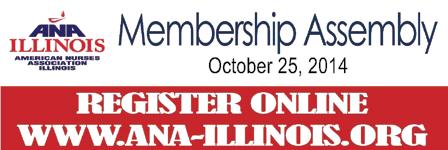
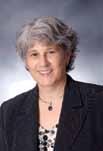
There are times in life when you end up in places you wouldn’t have ever expected to visit, both personally and professionally. In my work at Teen Living Programs, I provide primary care to homeless older adolescents. Our agency has a small clinic in the lower level of our residential facility. In the course of the last year, I started working with one of the attorneys from the Chicago Coalition for the Homeless(CCH), as he began assisting our clients to enroll first in County Care and then into Medicaid at our new drop-in center.
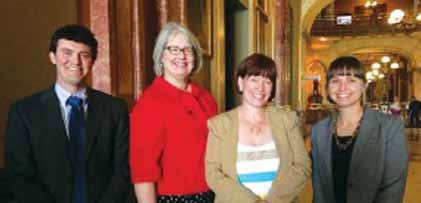
Last March, I received a phone call from one of his co-workers, the lobbyist for CCH. She asked me if I would consider going to Springfield to provide a brief testimony on behalf of HB 4501, which the CCH attorney had drafted. She explained the process and their expectations briefly and then said the testimony would need to be given Thursday at 8:30 am in Springfield. It was Monday afternoon. After a flurry of emails to my supervisor, our executive director and numerous drafts of my 3 minute testimony, I was feeling ready to go by Tuesday afternoon. I would drive down Wednesday from work, meet with CCH staff for dinner, we would all stay at the same hotel across the street from the state capitol building, have breakfast Thursday and go to the hearing.
The CCH lobbyist was extremely helpful. She edited my testimony much closer to three minutes. She explained the importance of keeping testimony short, getting in 3 – 4 interesting examples, and then she explained how the room would be set up, where we would sit and the process involved. Two days before, she had met with nearly everyone on the House Judiciary committee to seek their support for the bill and/or explain the importance of it. The only person on the committee she was unable to meet with happened to be the representative from my district. Interestingly, that Wednesday, while at work, I thought “I should contact my state rep and urge him to support this bill.” So I went online to send him an e-mail or get the phone number and call, and I found out he was actually on the Judiciary Committee! I made my phone call to his office and left a message with his secretary. Wednesday night at dinner, after relating this I was congratulated on my Jr. Lobbyist status.
On Thursday morning, since we arrived a little early, I was introduced to the rep. who sponsored our bill. I saw MY rep, and pointed him out to the bill sponsor, who then introduced me to my rep as one of his constituents. We chatted briefly. The hearing began and our bill was the second bill to be presented. As I sat waiting for my turn to speak, my mouth was dry and my palms were moist. I had to keep my paper on the table because my hands were shaking. “How did I get here?” I thought. However, once I started speaking, it was like explaining to my friends or family what I do at my job. It just flowed and was over in less than three minutes. There were no questions. That was a relief.
CCD staff thought it went well. I thought it went quickly! The lobbyist then took me on a tour of the beautiful and newly renovated capitol building, explaining what went on in the different rooms. She also asked me if I would be able to go down again to provide testimony for the senate judiciary committee a few weeks later assuming the bill would pass out of the house, which it did. I went again 6 weeks later, but then my testimony was not required. The bill passed unanimously out of that committee as well. Yesterday I learned that HB 4501 is now on the governor’s desk awaiting his signature. Yay!!
I learned a lot from this brief legislative experience. First, our representatives and senators DO want to hear from us. They are expected to make decisions on an incredible range of issues, and a little input can go a long way with them. Second, getting to know legislators is not like creeping across a rope bridge flung across a dark abyss. It is picking up a phone and making a call or emailing, or visiting an office. “They” are us. They are people with jobs who want to make a difference. Embracing opportunity can be exhilarating, empowering and rewarding. APNs are on the front lines, articulate, with strong knowledge and excellent communication skills. APNs can effectively advocate for hundreds or thousands by actively supporting those who do policy work.
I encourage every APN to take advantage of having your voice heard by your legislators. I now read ISAPN legislative updates with much greater enthusiasm and understanding. The more APNs put themselves out there, the more respect and influence gained. Collectively APNs can make a huge difference.



Dear Colleagues:
On behalf of the Editorial Committee, we seek your expertise for NURSING VOICE. We ask that you consider contributing to the Newsletter by submitting current professional articles and/or references of your choice. We will carefully review your submission, support your efforts and print the results as appropriate.
Ideas for a topic you may want to submit may include recommendations such as these:
• Acute Health Care Issues
• Medical Use of Cannabis
• Medicaid innovations
• The NPA
• Qualified and Safe health Care
• Fall Prevention
• Research of Current Issues in Health Care such as a Genome Project to Determine Individuals DNA for Future medical intervention.
• Global Ethical Issues in Health Care
The length of articles may be between 400-500 words.If they are research based, they may extend to 3000 words. You may freely submit them to Susan Swart, Executive Director, ANA-IL at P. O. Box 636, Manteno, IL 60950, or via E-mail at syswart@anaillinois.org
We look forward to sharing your experiences and skills as our valuable professional readers. Hence, please consider participating with us.
Editorial Committee, Illinois Nurses Foundation


Health care continues to evolve, and health care reform is described as “revolutionizing” the US health care system. Concurrently, the registered professional nurse (RN) role is rapidly expanding and changing. Much has been written about role expansion and change, and the subsequent need to better define the RN scope of practice. Very little has been published about the perception of registered professional nurses and their expanding and changing roles, what they believe might change in the future and what preparation they need for their future role. The ANA-Illinois expert panel is convening focus groups to gather information for exploring the Illinois RN’s perception about the expanding and changing scope of professional nursing practice. Focus groups will be conducted through February 2015. The research has received approval from the Blessing-Rieman College of Nursing Institutional Review Board. The results of this research will be analyzed for themes and used to update the Illinois Nurse Practice Act which sunsets in 2017. The American Nurses Association identifies a single scope of practice that encompasses the range of activities performed by the beginning registered nurse to the most advanced level of nursing practice. The scope of practice describes the who, what, where, when, why, and how of nursing practice (American Nurses Association, 2010).
Participant Selection: Applicants include registered nurses in Illinois willing to participate in a regional focus group. Not all applicants will be accepted for the study. (Explain rationale and reference) Representative convenience sampling will be used to populate these focus groups. The role of participants is to attend and participate in one assigned focus group, to be on time, and to openly share relevant experiences and perceptions with the group.
Time Commitment: Participants will be expected to give about an hour of their time to the focus group, and to speak with integrity and respect.
Confidentiality: In order to provide a high degree of privacy for participants, the sessions will not be held at employment sites; participants will not be contacted at work, nor will they be asked to identify themselves by employment site. Their name will not be used in any report that is published.
This discussion is strictly confidential and voluntary and participants do not have to take part if questions make them uncomfortable. They may leave the group at any time. Researchers do not believe there are risks involved in taking part in this study. This study may include risks that are unknown at this time.
Benefit: The benefit for participating in this focused study group is that the expert panel will have participants perspective, a better understanding of their current scope of practice and what they envision for the future. The information from these groups will be analyzed, published, and used to inform suggested changes to the Illinois Nurse Practice Act as it is revised in 2017.
All of this information will be available on the ANA of Illinois website under recent events. The application will take less than 10 minutes. Interested applicants may click on the below survey monkey link if they are interested in being considered as a focus group participant. The status of their application will be E-mailed to them during the first week of November.
SURVEY LINKhttps://www.surveymonkey.com/s/SCOPEFOCUSGROUP
ANA Illinois Expert Panel Members:
Pam Brown, PhD, RN, ANEF
Sue Carlson, MSN, RNC, CNS-BC, Kelly Fugate, ND, RN, HSMI
Jeanne, Little, MSN, APN
Beth Ann Christopher, MS, RN
Kathleen A. Brown, BA, RN, CDDN Karen Kelly, PhD, RN
• 3-year program of study (year round)
• Concept-based approach to learning
• Immersion trip options with Native Americans in South Dakota and Mayan and Latino populations in Yucatan, Mexico
• Multiple clinical opportunities in acute care and in the community
• One-on-one preceptorships in a variety of settings
• Scholarships and other financial aid available
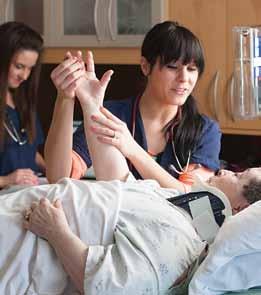

Region 4 in Champaign Urbana has three volunteers to the free clinic called Avicenna in North Champaign.
This clinic serves uninsured people of every race, and background. Due to the University, there is a wide cultural mix, and some of these people have ‘fallen between the cracks’, and need help to find health care. They are given resources.
The clinic serves adults with chronic conditions. There are no accommodations for urgent illness. A Registered Dietician meets with each patient regardless of the presenting complaint. This is a fantastic idea enhancing the entire encounter.
The clinic operates in Frances Nelson Health Center on Sunday afternoons. The following is from Clinic Director, Sam Logan.
Our Mission:
To provide healthcare for the uninsured and underinsured by providing preventative and curative care while promoting health awareness among the adults of Champaign County.
The need in Champaign County:
• Current population: 190,260
• People leaving in poverty: 23%
• People without a permanent medical home: greater than 20%
• People uninsured: 15% (county health ranking, 2013)
• Estimated undocumented uninsured ages 0-64: 1,584 (HMA/MCIC Analysis of 2009 American Community Survey Data for IL)
What about ACA?:
• Potential free clinic patients include undocumented immigrants, those choosing to pay the penalty for no insurance, those exempt from mandate and who chose to remain uninsured, citizens without documentation, students families, visitors
• PCP shortage, especially those who accept medicaid, will result in a greater need for free clinics
• Bottom line, we expect there to be a need for at least the next 4 years.
Services offered to patients:
• Manage acute and chronic illness. Pre-diabetics, IIDM, hypo/hyperthyroid, hypertension, constipation, coughs, colds, sore throats, skin tag removal, rashes, work physicals, physical exams.
• Nutritional concealing. Our clinic is set up so that every patient, after seeing a provider, has a consultation with our nutrition team. They assess, collaborate, and formulate a nutritional plan for most every patient.
• Lab work: We offer a set of lab tests free to our patients through quest diagnostics.
• Referrals: we make referrals to Francis Nelson frequently for patients who need more complex management. Also refer to an ophthalmologist, and mental health profession.
Services NOT offered to patients:
• IDDM
• TB screening
• Imaging
• Psychiatric medical management, including sleep meds, anti anxiety.
• Women’s health
• Pediatrics (we only see 18+)
• Pain management requiring narcotics
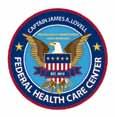

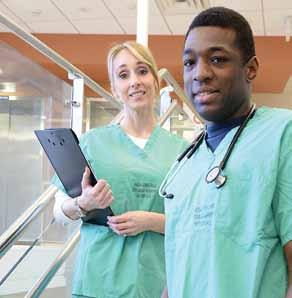

1.0 Contact Hours
This offering expires in 2 years: September 10, 2016
The goal of this continuing education offering is that participants will be able to recognize elder abuse when providing nursing care.
Learning Objectives:
1. Define Elder Abuse.
2. Describe the frequency and likely causes of elder abuse.
3. Recognize barriers to reporting elder abuse.
4. Recognize the healthcare professional’s role in dealing with elder abuse.
This course is 1.0 Contact Hours
1. Read the Continuing Education Article
2. Take the test on the next page
3. Complete the entire form
DEADLINE
Answer forms must be postmarked by June 10, 2016
Mail or fax the completed answer form. Include processing fee as follows:
ANA-Illinois members- $7.50 Non members- $15.00
Check or money order payable to Illinois Nurses Foundation (INF) or credit card information only
MAIL: Illinois Nurses Foundation PO BOX 636, Manteno, Illinois 60950 FAX: Credit Card Payments Only 773-304-1419
ACHIEVEMENT
To earn 1.0 contact hours of continuing education, you must achieve a score of 80% If you do not pass the test, you may take it again at no additional charge Certificates indicating successful completion of this offering will be emailed to you.
The planners and faculty have declared no conflict of interest.
ACCREDITATION
This continuing nursing education activity was approved by the Ohio Nurses Association (OBN001-91), an accredited approver by the American Nurses Credentialing Center’s Commission on Accreditation.

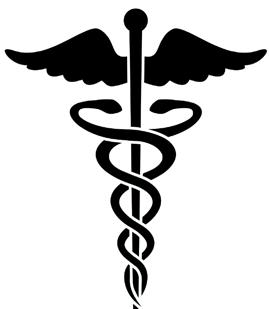
Presented by: Alma J. Labunski, PHD., MS, RN Consultant, Educational Challenges Within A Global Culture Retired Dean and Professor, North Park University, School of Nursing
INTRODUCTION:
What constitutes Elder Abuse? As declared by the World Health Organization (WHO), elder abuse is defined as a violation of an older adult’s fundamental rights to be safe and life free from violence. Recent estimates (Generations, Fall 2012) state that one in ten cognitively intact older adults experience abuse either physically, psychologically, sexually, with neglect and/or financial exploitation. Restated, elder abuse is varied wrongs against older adults and according to recent reports, abuse is escalating at major proportions as increasing number of elders are being targeted. Only a fraction of victims ‘abuse is reported. In fact, it has been reported that of those who are a victim of abuse, only 31% have reported their abuse (Pickering and Rempusheski, p.121)
FREQUENCY:
Although frequency in numbers remains undetermined, in this country and in the world, the aging population is rapidly increasing and increasing numbers of oldest oldthose eighty five and older. Predictions indicate that by 2025, the global population of those 60 years and older will double to 1.2 billion. The number of older adults will exceed the number of children for the first time in history. (Greenlee, p. 6).
Hence, more older adults equal more likelihood of elder abuse. As older adults remain in their own homes, they are often targeted by criminals preying upon their limited resources. Those with dementia are at even greater risk of abuse than those without cognitive impairment.
Although difficult to pin down, existing prevention, detection programs and research that affect an understanding of the problem’s causes must be underway in order to gain a full understanding of the complex problem and its causes.
Early studies focused on burdened caregivers who reported that they didn’t have adequate support and
resources. According to this approach, the elderly victim is viewed as very dependent on the caregiver, usually an adult daughter, who becomes frustrated, angry and abusive because of the continuous caretaking needs of the parent. However, is that the primary cause of elder abuse?
Today’s caregivers are as diverse as the older adults in their care. Offenders can be spouses, partners, family members, caregivers and others in positions of trust. Given the complexity of these cases, no single intervention, response, or policy is solely going to address the problem.
Although stress appears to be a predictor, it is not clear as to the basic cause/s of abuse. Therefore, no singular identifier can explain the rationale for its existence. Nonetheless, oftentimes, an offender uses a pattern of coercive tactics to gain and maintain control over the victim. Isolation, threats, intimidation, assuming all household money matters, etc., are forms employed by abusers. Greed appears to be a primary source of financial exploitation taking over all primary sources of financial exploitation upon elders. (MMI, 2011; Generations, p. 34).
Additional assumptions include blaming the victim because the victim is very ill and difficult for whom to care. Others reflect a sympathetic view of caregivers who are overwhelmed with care and prey on professionals, family and friends regarding the stressors. Henceforth as reported by Brandl and Raymond, (p. 35). As the authors contend, if professionals continue to perceive elder abuse as a family problem, rather than a national one, focus will continue to remain on individual remedies rather than social justice response. (pp. 36-37).
In sum, the greatest risk factors for elder abuse appear to be disability – with movement into financial exploitation, low income, poor health, decreased social support reflecting predicted neglect, perpetrators who are unemployed, substance abusers, and mental health problems.
Prevalence is greater among residents within long term care facilities. A study conducted by Adult Protective services (APS) in five states over a period of six months was conducted in two phases. During phase
Continuing Education continued on page 10



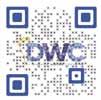



One, 429 cases of reported sexual abuse were made and investigated. (Ramsey-Klawsnik and Teaster,p. 53).
Continuing Education continued from page 9 of victims’ services such as safe havens. However, as reported by Pickering and Rempusheski (p. 124), although progress has been made in combating elder abuse, the ”essential first step is increasing public awareness of elder abuse and creating opportunities for community-based educational programs to increase reporting and victims’ identification” (p. 124).
Locations varied; mental hospitals, group homes, nursing homes, and state schools. The mean age of victims was 49.8 years. The 124 alleged elderly victims had a mean age of 79; 77% were female. Among the 463 perpetrators, 74% ranging in age from 16-96 were male. During phase Two of the study, 72% were invited and agreed to be interviewed. Of the many investigations, one facility reported confining a victim to her room for days to prevent further sexual assault from another resident. Results of the study provided recommendations for future investigations: increased case handling, increase security and supervision, conducting background checks of potential employees, single-sex housing for residents and avoiding male care giving staff for female residents (Ramsey-Klawsnik & Teaster, p. 57). Results of another study indicated fourfifths of nursing home personnel witnessed abuse against a resident (Antzberger, p. 14). Reports also indicated that two-fifths committed abuse in the prior year.
Barriers to reporting elder abuse are numerous: fear of retribution, isolation, rationalizing abusers’ behaviors, dependency of the abuser on the victimized older adult, reluctance to report family members’ abuse for fear of institutionalization are common identifiers. Caregiver may lack understanding of the definition and context of elder abuse, such as caregiver withholding medicine, which causes elder to become sick and require hospitalization. Also, cognitively stable victim is locked inside the house, but locked out of the pantry in order to withhold food intake (Pickering & Rempusheski, P. 123). Nonetheless, the most common reason to avoid reporting elder abuse is the individual’s fear of being institutionalized and placed in a nursing home facility. And, when the elder is encouraged to report, the individual hesitates to report to a physician or a nurse when incurring the greatest abuse, especially when it is related to the elder’s adult child as caregiver.
Henceforth, health care professionals should ask specific questions about the possibility of abusive acts in a variety of situations rather than simply asking “do you feel safe at home?” As indicated in the section, Professional’s Role below, appropriate questioning support the greater need for investigation and educational intervention for community dwelling older adults.
The Elder Justice Act as a section of the Affordable Care Act, increases federal response to elder abuse and is intended to provide funds for increasing prosecution efforts and forensic capacity and funds for creation
On a positive note, forty years ago the federal government within the Older Americans Act (OAA) established a long term Ombudsmen program to address widespread abuse in nursing homes. Since that time, reports of abuse constitute a majority of nursing home complaints. In fact, in 2010, 7.1% of all nursing home complaints listed abuse, primarily physical abuse as the basis for complaints.
Encouraging news reported by Miller (p. 61), over the past five years, documented that the number of physical abuse complaints have decreased by approximately 1000. Likely due to ombudsmen monitoring, the author confirms that ombudsmen are serving on the front lines, and are continuing to seek improvement in quality of care and prevention of abuse in long term care facilities.
First and foremost are health care professional’s observations, monitoring and inquiries of individuals. Close interaction is critical; also, close observation of abusive signs – physically – such as bruises, or other abusive signs, observing reactions to caregivers’ presence, non verbal reactions to specific inquiries etc.
Professionals have a responsibility to be accountable for their patients. Since abuse is often insidious and concealed, professionals must take the leadership to increase visibility, acknowledge, speak out and take action regarding their observations. Elder abuse is robbing older adults of their safety, their health and their financial resources. Reluctance in reporting abuse may surface as patients are urged to report even services which include community-based services that the elders may be educated to use or are already using. More information (Geriatric Nursing, 2014, p. 124) may be available through the service being utilized.
Hence, the first step is to increase other professionals’ awareness of elder abuse via preparing and presenting continuing education programs for them. Creating opportunities for the community-based educational programs is critical to increase reporting and victim identification. It is important to note, however, that reluctance in reporting abuse may surface as patients are urged to report even community-based services that elders are being educated to use or are already using. ((Pickering & Rempusheski, p. 124)
As stated, elder abuse is a crime; doors cannot be kept closed and hidden indicating abuse as a family and personal problem. It is a national social justice problem.
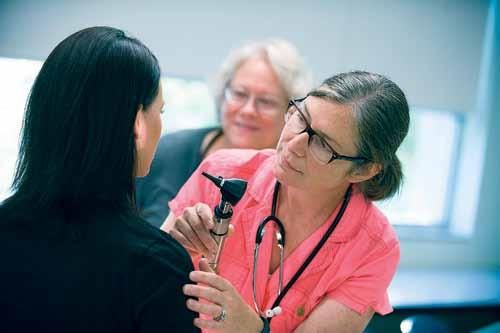

On a national scale, the National Clearinghouse on Abuse in Later Life was created in 1980, however, has not changed its response to abuse since that time. Professionals must take the leadership and be accountable by considering specific issues, moving into programs for assistance and freely utilizing the services available. Further, the United States Administration on Aging (USAOA) has provided federal leadership to help address the huge criminal problem. Great progress has been made in recent years to enhance the federal role regarding abuse. In 2011, a first time, federally funded (Greenlee, p.8) National Adult Protective Service Resource Center was established to enhance and improve consistency and quality of programs and services nationwide. Also, for ten years, advocates have worked with Congress to pass the “Elder Justice Act” which became law in 2010. A total of 600 organizations have signed on to support the Act, issues and the goals, but it has yet to receive an appropriation. And, in spite of advancing the field, no changes have been made in response to abuse since 1980. (Blancato, P. 11)
The Department of Justice has a new elder abuse road map project, and agencies such as the Federal Trade Commission and the Securities and Exchange Commission, who are working to combat elder abuse. While no organization or financial legislation can end violence, all Americans have a responsibility to do everything in their power to help victims. A national response must be developed. While many have considered the abuse issue as federal, it remains a global crisis, one that each professional should consider as his/her personal priority for elders, families and friends.
Anetzberger, Georgia. (Fall 2012). Update on the nature and scope of elder abuse. Generations, 36 (3), 12-20. Blancato, Robert. (Fall 2012). Elder abuse and the elder justice movement. Generations, 36 (3), 6-8. Brandl, Bonnie and Raymond, Jane. (Fall 2012). Policy implication of recognizing that caregiver stress is not the primary cause of elder abuse. Generations, 36 (3), 32-37.
Greenlee, Kathy. (Fall 2012). Take a stand against elder abuse. Generations. 36 (3), 6-8
Metlife Mature Market Institute (MMI). (2011). Metlife study of elder financial abuse. Generations, 36 (3), 7. Miller, Mark (Fall 2012. Ombudsmen on the front line improving quality of care and preventing abuse in nursing homes, Generations 36 (3), 60-63. Pickering, Carolyn and Rempusheski, Veronica. (March/ April 2014). Examining barriers to self-reporting of elder physical abuse in community-dwelling older adults, Geriatric Nursing, 35 (2) 120-125.
Remsey-Klawsnik, Holly and Teaster, Pamela. (Fall 2012). Sexual abuse happens in health care facilities – what can be done to prevent it? Generations, 36 (3), 53-59.

1. Due to great longevity of older adults, elder abuse is likely due to:
1. Lack of available family
2. Being targeted by criminals
3. Caregivers stress
4. Elder disability
a. 1, 2, 3, 4
b. 2, 3, 4
c. 2, 4
d. 1, 2, 4
2. Prevalence of elder abuse within institutions is:
a. decreasing
b. Revealing greater investigations
c. Escalating
d. Unreported
3. If elder abuse is unreported, barriers to lack of reporting include:
a. Fear of retribution
b. Fear of isolation
c. Feat of institutionalization
d. All of the above
4. The Elder Justice Act is designed to:
a. Increase federal response to elder abuse
b. Provide for ombudsmen
c. Assist caregivers’ resources
d. Support victims within their own state
5. The Elder Justice Act is a section of the:
a. Administration on Aging
b. National Clearinghouse on Abuse
c. Older American’s Act
d. Affordable Care Act
6. The Ombudsmen program has been established to address:
a. Department on Aging Complaints
b. Crime in the United States
c. Service for widespread abuse in nursing homes
d. Service for Rehabilitation in nursing homes
7. Federal funds for elder abuse are intended to:
1. Support prosecution efforts
2. Forensic capacity and funds for victims’ services
3. Safe havens for victims
4. Increased federal response to elder abuse
a. 1, 2, 4
b. 1, 3, 4
c. 2, 3, 4
d. 1, 2, 3, 4
8. Professionals’ responsibilities should be prioritized as follows:
a. Close observation, inquires of individuals, presenting continuing education programs
b. Close observation, inquires of individuals, monitoring patients, close interventions
c. Inquiries of individuals
d. Presenting continuing education programs, inquiries of individuals
9. Professionals have responsibility to create opportunities for presenting continuing education programs. Components of the programs should include:
1. Physical abusive signs
2. Non-verbal reactions to inquiries
3. Observing responses to caregivers
4. Steps in reporting abuse
5. Signs of financial exploitation
a. 1, 2, 3, 4, 5
b. 1, 2, 3
c. 1, 3, 4, 5
d. 1, 5
10. Upon close observation of a patient, the professional observes abusive signs. The nurse’s FIRST responsibility is to:
a. Inquire of locus of bruises
b. Observe interaction with family
c. Maintain contact with patient
d. Report observations
Please circle the appropriate letter
(Please PRINT clearly)
NAME
ADDRESS
PHONE
EMAIL ADDRESS (required to receive CE certificate)
Evaluation- CE Elder Abuse: Challenges for Health Care
Learner achievement of objectives:
Define Elder Abuse.
Describe the frequency and likely causes of elder abuse.
3. Recognize barriers to reporting elder abuse.
4. Recognize the healthcare professional’s role in dealing with elder abuse.
How many minutes did it take you to read and complete this program?
Suggestions for improvement? Future topics?
ANA-ILLINOIS MEMBER $7.50 ANA-ILLINOIS ID# NON MEMBER $15.00
METHOD OF PAYMENT
MONEY ORDER CHECK VISA MASTERCARD (note: a fee of $25 will be assessed for any returned checks)
CARD NUMBER
EXPIRES CVV #
Signature Date
Mail all tests to: INF, PO BOX 636, MANTENO, ILLINOIS 60950


ImmedIate employment Opportunities:

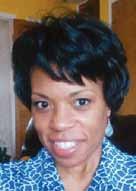
Robyn Jackson has just been promoted to the position of director of the ICU/TCU, ED and Stroke Program at Advocate Trinity Hospital. Jackson has been with Advocate for two years and instrumental in the improvement of patient outcomes in the critical care setting. She motivates her team to adopt evidenced based practice initiatives resulting in a reduction of hospital acquired conditions. Under her leadership ventilator length of stay has been reduced by 60%.
As a nurse leader, Ms. Jackson has been committed to empowering frontline staff to become transformational leaders. She promotes collaboration across disciplines and has evolved the practice of multidisciplinary rounds in the community hospital setting to which she contributes much of the success. It has become an effective tool in improving safety, collaboration, front line leadership, and patient outcomes. She has implemented multiple evidenced based practices such as Sepsis Alert, Therapeutic Hypothermia, and Family Presence at the Bedside in Emergent Events. As a result, the associates’ perception of the quality and safety of care provided to patients at Trinity in Critical Care exceeds the 90th percentile.


Olivet Nazarene University’s School of Graduate and Continuing Studies (SGCS) announces a new educational partnership with the American Nurses Association (ANA) Illinois and its affiliates, Illinois Society for Advanced Practice Nursing (ISAPN), Philippine Nurses Association of Illinois (PNAI), Illinois Association of School Nurses (IASN), and Illinois Hispanic Nurses Association (IHNA).
This new relationship includes a tuition incentive of a 20 percent discount for Olivet’s RN to BSN degree completion program — both the online and hybrid programs — as well as the MSN degree programs. Newly added are three business degrees as well: Masters of Business Administration (available with a healthcare focus), Masters of Organizational Leadership, and Bachelors of Business Administration – all available online. Olivet is looking forward to reaching and welcoming to its student body more nursing students from all areas of Illinois and beyond.
Through its educational partnership with ANA-Illinois, Olivet is extending this tuition incentive to all members of affiliate organizations as well. As the recognized leader in serving the needs of nurses and the nursing profession, ANA-Illinois invites other nursing organizations to partner with it as organizational affiliates.
ANA-Illinois is committed to helping registered nurses (RNs) achieve their professional and educational goals.
“By pursuing a bachelor’s or advanced nursing degree, RNs can operate from a broader knowledge base for the benefit of patients and families,” said ANA-Illinois Executive Director Susan Y. Swart, MS, RN, CAE. “Additionally, baccalaureate and advanced-degreed RNs benefit from enhanced career prospects in various areas, including teaching, research, administration, and advanced practice.”
ANA-Illinois is the professional association for registered nurses in Illinois. Together with its national partner, the American Nurses Association (ANA), this organization is focused on building a community of nurses dedicated to advancing their profession and providing safe, affordable healthcare. As an advocate for the nursing profession, it works to provide a voice for all nurses across all specialties and practice settings.
In addition, ANA-Illinois is committed to protecting the practice of nursing by ensuring that nursing’s priorities are incorporated into legal and regulatory decisions. Important issues — such as oversight of scope of practice, appropriate use of unlicensed personnel and the impact of managed care — are foremost in the organization’s work. It also focuses its efforts on safeguarding and promoting licensure, credentialing and the right of the profession to define nursing practice.
To learn more about the ANA Illinois-Olivet Nazarene University please visit our custom landing page at: http://graduate.olivet.edu/ana-illinois-partnership





The Illinois Board of Higher Education (IBHE) and the Advisory Board for the Illinois Center for Nursing recognized the 2014 Nurse Educator Fellows on June 5, 2014 in a joint ceremony held in Chicago and Springfield. This distinguished group of nursing faculty were nominated by their schools and competed against 28 applicants to become part of this select group of Fellows. The program helps to ensure the retention of well-qualified nursing faculty at institutions of higher learning by providing a one-time salary supplement. The fellowship was reinstated into the FY2015 budget. This fall the IBHE will be seeking new nominations for the program, please check the IBHE website, tab: Grants: http://www.ibhe.state.il.us/Grants/default.htm
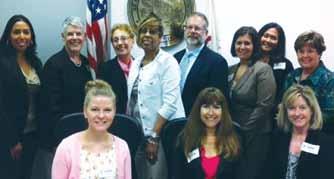
In Chicago: Standing, left to right - Elizabeth Florez, PhD, RN, DePaul University; Catherine Vincent, PhD, RN, University of IL at Chicago; Marsha Snyder, PhD, RN, PMHNP, BC, CADC, University of IL at Chicago; Lola M. Prince, PhD, RN, APN, FNP-BC, University of St. Francis; Frank D. Hicks, PhD, RN, Rush University; Amber S. Kujath, PhD, RN, Rush University; Daisy Sherry, PhD, CNP, RN, Lewis University; and Patricia Kelly, MSN, RN, CNE, St. Xavier University. Seated, left to right - Julianne Jagielka, DNP(c), RN, Morton College; Annette Mattea, DNP, RN, APN/CCNS, University of St. Francis; and Jacqueline Tulley, MSN, ACNP, RN, St. Xavier University.

In Springfield: Left to Right - Sheryl Jenkins, PhD, RN, IL State University; Tina Saddler, MS, RN, Western IL University; Debra Stark, PhD, RN, Methodist College; Jonathan Lackland, IBHE Deputy Director, Jill Parsons, PhD, RN, MacMurray College; Teresa Valerio, DNP, APN, FNP-BC, CBSM, IL State University; and Michele Beatty, PhD(c), RN, SIU-Edwardsville.
Unable to attend – Karen Brandt, PhD, RN, NIU; Noel Kerr, PhD, RN, IL Wesleyan University; and Lisabeth Searing, PhD, RN, IL Wesleyan University.

CHICAGO—Bonnie Barnes, co-founder of the DAISY Foundation, and Janet Silvestri, DAISY regional program director for the northeast, arrived at Advocate Trinity Hospital today to help present an award to one of the hospital’s nurses. They visited Chicago for a conference and insisted on coming to Trinity Hospital to thank nurses for all their hard work. The DAISY Award is an international program that rewards and celebrates the extraordinary clinical skill and compassionate care given by nurses.
“Nurses are truly angels. They always say ‘I didn’t do anything special, but they do save lives,” said Barnes. “They help patients and their families. They are so magnificent and make such an impact. You always need Kleenex when you hear the stories about how much these nurses do.”
Chester Bell, a patient at Trinity Hospital in March, nominated Justina Anaele, a nurse on 4 South, for her tireless work in helping him through the difficult decision to get surgery. He described her as someone with a big smile, a soft voice like an angel and one of the main reasons he is alive today. “She was able to help me past my fear with her pep talk and her advice, and I was able to make the best decision for myself to do a surgery that I had previously refused to do,” said Bell, of Chicago.
Doctors had advised Bell to have surgery last year, but his crippling anxiety caused him to walk away. He felt nobody was listening to him when he talked about his apprehension. Until he spoke with Anaele. “She was patient with me, compassionate and ready to hear me verbalize my fears and concerns. She was able to help me overcome my fears and anxiety. She took time to explain the procedure to me and the effects of not doing the surgery and calmed me down by telling me more about the surgeon, Dr. Gregorio Aglipay.
Within a few minutes, Dr. Agilpay came in and spoke with Bell, repeating the importance of having the surgery. In less than an hour a transporter came to his room to take him to surgery.
“Nurse Justina always came to see me, called to check on how I was doing during her off days,” said Bell. “I am really proud and excited that Trinity Hospital had somebody that helped saved my life. I thank God for her.”
Anaele was in tears when she found out she received the award. “I could have never done it without the support of the people here at Trinity,” she said. “They made me a better nurse.”
Linda Plewniak, director of Nursing Professional Development and Innovation, thanked Barnes for coming to the special event. She said the DAISY Foundation Awards are special with each nurse taking pride in their work.
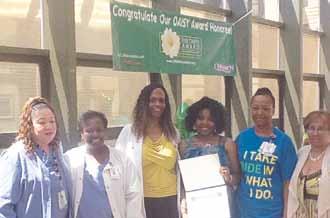
After 25+ years as the Executive Director of the Campaign for Better Health Care and as a leader in the Illinois Health Care Justice Movement, Jim Duffett is leaving the state he has served so diligently. He is moving with his family to North Carolina where he will continue to fight for social justice. Below are two pictures of Jim and nurses who have worked with him and the CBHC over the past many years at his farewell party this past June. For more information on the CBHC www.CBHCONLINE.org
During the June 26, 2014 celebration Pam Robbins, RN, CBHC Board member presented an Ode to Jim Duffett along with a thank you:
“It is just wonderful to have an award that recognizes some of the great work that nurses do in everyday situations. They don’t look for any credit. They just want to do their jobs,” said Plewniak.
The DAISY Foundation was established in 1999 by the family of J. Patrick Barnes who died of complications of the auto-immune disease Idiopathic Thrombocytopenia Purpura (ITP) at the age of 33. During Pat’s eight- week hospitalization, his family was awestruck by the care and compassion his nurses provided not only to Pat but to everyone in his family. So one of the goals they set in creating a Foundation in Pat’s memory was to recognize extraordinary nurses everywhere who make an enormous difference in the lives of so many people by the super-human work they do every day.
DAISY is an acronym for diseases attacking the immune system. Today, the DAISY award program is active in 1,700 facilities, 11 countries and honoring more than 40,000 nurses. Patients, family members, friends and co-workers submit nominations for DAISY winners, who are typically honored on a quarterly basis. They receive a certificate, daisy pin, cinnamon rolls and a special hand-carved gift.
About Trinity Hospital
Providing healthcare on the Southeast Side of Chicago for over 115 years, Advocate Trinity Hospital is a 193-bed not-for-profit health care facility. Part of Advocate Health Care, Trinity offers a full range of inpatient and outpatient services as well as a variety of community outreach programs. For more information on Trinity, please visit www.advocatehealth.com/trinity
Internationally Educated Nurses (IENs) are a hidden and unrecognized resource for the American health care system. Based on previously unavailable data from the American Community Survey, there are approximately 10,300 foreigneducated immigrant nurses in the Illinois labor force most of whom are working in low paying jobs that do not recognize or use their previous education or skills, This valuable source of nurses can help to diversify our nursing workforce as well as address a serious need for bilingual and bicultural care for immigrant and monolingual patients and families in Illinois. IENs can contribute by strengthening our health care work force and the economic stability of our families, our communities, and our entire state. There are a number of barriers that frequently delay the entrance of these nurses into the Illinois nursing workforce. Examples include language proficiency, lack of knowledge of the U.S. and Illinois nursing licensing process, and a lack of financial resources.
The major challenge for IENS is communication and fluency in English. In Illinois, each IEN who has qualified as a first-level nurse (equivalent to RN) must pass the Test of English as a Foreign Language (TOEFL) examination or the International English Language Testing System (IELTS) prior to taking the National Council Licensure Examination for Registered Nurse (NCLEX-RN®). Ideally, nurses needing to improve their English would enroll in accelerated English for Speakers of Other Languages (ESOL) classes that take advantage of their levels of prior educational attainment and whose content is contextualized for the nursing profession – i.e. teaching language and terminology used by nurses in the workplace. Unfortunately, most Illinois
I joined the team in 2008; Met Mr. Duffett whose passion was great, He’s driven to fight for those who can’t; On affordable healthcare, he goes to bat. His message on “access” there is no doubt; That everybody’s in – and nobody’s out! He’s taught me strategies to win this fight; Sometimes disappointed – he has never lost sight. Healthcare is definitely everyone’s right; Jim will never give up – we will win this fight!
Thank you Jim for teaching this old nurse how to articulate the benefits and rationale that everyone deserves the options to purchasing affordable healthcare benefits. In our Nurses Code of Ethics, it proclaims the nurses’ role in social justice is advocating on behalf of those who cannot advocate for themselves. With this assembly including a cadre of nurses here to honor you for your superhuman efforts to achieve affordable healthcare for all – I express our heartfelt thanks for your unwavering spirit accomplishing access to healthcare in Illinois.

community colleges do not provide TOEFL courses so students are referred to universities or for-profit educational organizations. Frustrated by the “one-room schoolhouse” nature of most ESOL classes and lack of relevance to their employment and learning needs, they frequently drop out of classes, attempting to prepare and pass the NCLEXRN® without completing a lengthy series of conventional ESOL classes. For some, by the time they are competent in English; their nursing skills are no longer current.
Over the past twelve years the Chicago Bilingual Nurse Consortium (CBNC) has worked to provide services for IENs as they navigate through the licensure process. Ideally internationally educated nurses seeking information about licensure are directed to the CBNC where they receive individualized counseling that best fits their educational background and their readiness to enter the licensuring process. An initial interview and assessment of documents along with a one on one conversation with the candidate clarifies their individual needs. This enables CBNC to develop a plan that best suits each and every IEN and helps them overcome some of the barriers they have or will encounter.
CBNC encourages candidates as well as individual nursing leaders in the community to refer IENs in Illinois to the Consortium. Please feel free to contact CBNC for more information or to set up an appointment.
Chicago Bilingual Nurse Consortium
2525 South Michigan Ave., Office 247-C Chicago IL 60616
P: 312-567-2065, F: 312-567-7941
www.chicagobilingualnurse.org



Thank you Illinois RN’s! The Illinois Center for Nursing (ICN) collected almost OR more than 53,000 responses from Illinois RNs at the end of the 2014 online licensure renewal process. The survey included all questions from the national minimum data set http://www. nursingworkforcecenters.org/minimumdatasets.aspx , plus 5 additional questions. Approximately 90% of IL RNs renewed their license through the on-line licensure renewal process. The IDFPR on-line licensure renewal period began early in March, 2014 and ended May 31, 2014.
The ICN Board will use this data to plan and project workforce needs. During the summer the ICN Board began its analysis of the data. Preliminary results include: that less than 10 responders were born in 1930; approximately 200 responders were licensed for the first time in 2014; approximately 10% work more than one job; and, 94% of responders were women. Initial Illinois RN workforce reports are planned by the end of 2014.
Registered nurses represent the largest profession within the US health workforce, with more than 2.7 million RNs employed in 2010 (The US Bureau of Labor Statistics (BLS) 2012). BLS forecasts demand for RNs will result in 3.5 million nursing jobs by 2020, marking a 26% increase over 10 years. Demand is driven largely by population growth, and by the increasing number of older Americans who require more health care services. The Affordable Care Act (ACA) will likely impact the places where RNs work and the skills they need to be successful in these settings. The most rapid growth is in outpatient settings, ambulatory care, and home health care environments.
The ICN Board will use this data with their continued strategic planning, with a focus on nursing workforce development that impacts access to quality health care policy, practice and education in this era of change. Visit the ICN website, http://nursing.illinois.gov

This Illinois Center for Nursing (ICN), under the leadership of Chairperson Donna Hartweg, PhD, RN and Maureen Shekleton, PhD, RN, FAAN, Vice-Chairperson, are strategizing for the future. The ICN Board immersed itself in strategic planning during the February 2014 board meeting.
“The central challenge at this time of unprecedented healthcare change is to optimize ICN’s influence as the leader for nursing workforce development to impact quality healthcare policy, practice and education”, Donna Hartweg, summarizing for the ICN Board.
Results include a strategic map, revised vision, central challenge, and a focus of activity in four areas (data, partnerships, resources and PR/marketing) that support ICN’s mission, which is to advocate for and ensure appropriate nursing resources necessary to meet the healthcare needs of the citizens of Illinois. Through these efforts, ICN promotes access to healthcare, improved quality and decreased cost.
Background: ICN was established through legislative action in 2006, and placed within the Illinois Department of Financial and Professional Regulation to address issues of supply and demand in the nursing profession. Comprised of eleven members with diverse expertise appointed by the governor, the Center is administered by a managing director. Since its inception, ICN has established multiple coalitions with regional, state, and national organizations to address the statutory mandate.
Strategic Assessment:
I. Accomplishments: Overall quality and capacity in RN and LPN programs has increased through multiple initiatives: (2006-2013) in part because of multiple methods:
a. Coordinated with Illinois Board of Higher Education for nursing program grants:
• 19 Nursing School Expansion and 23 Improvement grants awarded (2007-2014)
• 117 Nurse Educator Fellowships awarded with 88.5% retention rate of educators in nominating schools of nursing (2007-2013).
b. Collaborated with national workforce groups, such as the Robert Wood Johnson Foundation (RWJF)/American Association of Retired Persons Foundation (AARP) Center to Champion Nursing in America (CCNA). Through CCNA leadership, ICN has partnered with ANA-Illinois, the Illinois Nurses

Foundation and the Illinois Organization of Nurse Leaders to form the Illinois Healthcare Action Coalition (IHAC), resulted in receipt of the RWJF State Implementation Program grant to support the work of the Illinois Healthcare Action Coalition, which is working on a seamless curriculum for progression between community colleges and higher degree programs, study of the supply of advanced practice nurses; and strengthening nurse leadership.
c. Worked with regional partners such as the Metropolitan Chicago Healthcare Council, Man-Tra-Con Corporation, the Illinois Hospital Association, the Illinois Critical Access Hospital Network, to become one of only three states chosen to be in the National Council State Board of Nursing Transition to Practice study.
d. Collected data on nursing workforce in concert with the national nursing minimum data set and dissemination of information on nursing and nursing programs via ICN website http:// nursing.illinois.gov
II. Issues: projections of mass retirements of RNs and increased demands for advanced practice nurses, nurse educators, and those with new competencies (US Department of Labor, Bureau of Labor Statistics Employment Projections for 2012-2022). This demands understanding of national and state supply/demand.
Recommendations based on ICN Strategic Planning in February 2014:
• Significant current and new data must be collected, aggregated and analyzed to better understand Illinois nursing workforce needs.
• Key strategic partnerships will be needed to facilitate the work of the CIN
• Utilize existing state funds and seek additional non-state resources • Increase visibility and communicate the value of the ICN.
The ICN is working with industry professionals and educational institutions to ensure that Illinois has a nursing workforce necessary to meet the demands of a growing and aging population. Visit the ICN website, http://nursing. illinois.gov

The Affordable Care Act (ACA) has put in place comprehensive reforms that have improved access to affordable health coverage. For the uninsured, new pathways to coverage have made it easier to get and stay covered. We will continue to need more nurses, particularly in outpatient settings to care for the newly insured and the increasing number of baby-boomers who continue to retire.
The Illinois Healthcare Action Coalition (IHAC) Education Workgroup is working to create a system that allows nursing students to progress from an associate degree program to an advanced degree program utilizing one admission process and standardized or universal curriculum. This proposed new system would allow students to move through the higher education system without loss of coursework credits and time. This seamless progression model will allow for schools to graduate more RNs in order to meet the healthcare needs of the state. New and innovative strategies must be developed to facilitate a seamless progression throughout all levels of nursing education.
The IDFPR/Illinois Center for Nursing worked with the IHAC Education Workgroup to both develop and distribute a survey to assess support for a proposed standardized RN nursing education curriculum. The on-line survey was distributed to all Illinois nursing prelicensure RN associate, hospital, baccalaureate and postlicensure baccalaureate completion programs between

March and May 2014. With an 80% response rate, there was support for a standardized curriculum as described in the survey, promoting seamless RN education transition.
The subject of seamless RN education transition has also been on the agenda of Illinois nursing education organizations. These state nursing education organizations, Illinois Association of Colleges of Nursing (IACN), Illinois Community College Board (ICCB) Deans and Directors and Illinois Organization of Associate Degree Nursing programs (IOADN) meet quarterly. At least twice a year, a portion of each meeting is held jointly, discussing topics of mutual interest. The priority topic for this group during these meetings has also been the standardization of Illinois RN nursing curriculum.
The IHAC Education Workgroup has developed a position statement on seamless academic progression for nurses, which is available on the IHAC website: http:// www.illinoishac.com/workgroups/education/educationprojectscollaborations/
The IHAC Education Workgroup continues to meet to determine involvement of regulatory agencies to work with the standardization of RN nursing education curriculum, to eliminate competition among programs, to work towards a comprehensive database for all programs and requirements. The Illinois Center for Nursing (ICN) website http://nursing.illinois.gov/education.asp has a list of all RN baccalaureate- completion nursing education programs.

Nurses want to provide quality care for their patients.
The Nurses Political Action Committee (Nurses- PAC) makes sure Springfield gives them the resources to do that.
Help the Nurses-PaC, help YOU!
So. . . . . . . if you think nurses need more visibility if you think nurses united can speak more effectively in the political arena if you think involvement in the political process is every citizen’s responsibility.
Become a Nurses-PaC contributor tOdaY!
❑ I wish to make my contribution via personal check (Make check payable to Nurses-PAC).
❑ I wish to make a monthly contribution to NursesPAC via my checking account. By signing this form, I authorize the charge of the specified amount payable to Nurses-PAC be withdrawn from my account on or after the 15th of each month.
(PLEASE INCLUDE A VOIDED CHECK WITH FORM)
❑ I wish to make my monthly Nurses-PAC contribution via credit card. By signing this form, I authorize the charge of the specified contribution to Nurses-PAC on or after the 15th of each month.
❑ I wish to make my annual lump sum Nurses-PAC contribution via a credit or debit card. By signing this form, I authorize ANA-Illinois to charge the specified contribution to Nurses-PAC via a ONE TIME credit/debit card charge.
❑ Mastercard ❑ VISA
Credit card number Expires CVV
Signature:
Date:
Printed Name:
E-Mail:
Address:
City, State, Zip Code:
Preferred Phone Number:
Please mail completed form & check to:
ANA-Illinois
Atten: Nurses-PAC PO Box 636 Manteno, Illinois 60950





